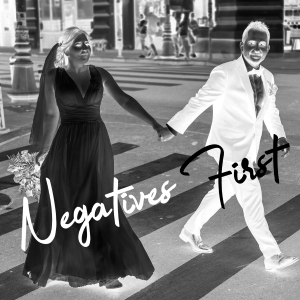Let's hear it for Negatives
First Wedding Planning
 Think positive. Be positive. Is the
contemporary mantra about everything. Including
wedding planning. However, while it might seem
counter-intuitive, doing the opposite when planning
your wedding is absolutely the best way. Focus on
the negatives (as in what are the things you
definitely don't want) to kickstart your planning.
In fact, I've built it into my process with couples
and it delivers tremendous results.
Think positive. Be positive. Is the
contemporary mantra about everything. Including
wedding planning. However, while it might seem
counter-intuitive, doing the opposite when planning
your wedding is absolutely the best way. Focus on
the negatives (as in what are the things you
definitely don't want) to kickstart your planning.
In fact, I've built it into my process with couples
and it delivers tremendous results.One of the first things I discuss with couples when we start getting down to the nitty gritty of what they want for their ceremony is what they don't want. In an industry where we focus on a couple's wants for their ceremonies, that might seem a very odd thing. It is not. It is a methodology that delivers huge benefits, saving time and quickly reducing what seem like infinite possibilities to much more manageable numbers because it points the way to eliminating broad categories rather than minute specifics. The specifics will come later.
For example, the one thing that every marrying couple must have is someone authorised to solemnise your marriage. 'Negatives First' planning will very quickly narrow down whether that person should be an Authorised Marriage Celebrant, like myself, a member of the clergy, or a State-Appointed Marriage Officer. And that will help to eliminate some broad categories of venue.
'Negatives First' planning
is a natural inclination where the choices are
overwhelming
qu
When we are faced with many alternatives it is a
natural inclination to reduce the overall number of
things we need to choose from down to a manageable
number. That's the concept behind the practice of
shortlisting. While it is possible to shortlist
positively, that is, only put something on the
shortlist if it meets all your criteria, a far more
efficient, and arguably more effective, way is to
reduce the number of possibilities before you spend
a lot of time on each one. . This is a common method used by people recruiting to fill a position. It is also a method that is often used when you are letting your fingers do the walking. You do a quick scan to identify a single reason to exclude a service or option from your list of possibles. And once you have found one reason, you spend no more time on that particular option. When people are recruiting staff, it happens on a first scan of the application. When you are Googling, it's the information on the website or Social Media that constitutes a substitute for an application.
Let's step away from wedding planning and look at what happens when you are in the market for a new vehicle. You might think you have made a positive decision to buy, for example, a 4 door sedan, but, in reality, you have already decided against a 2 door, a hatchback, a convertible, a hatchback, or a ute. That you haven't registered that you have already made multiple Not That decisions that have reduced the list of possibles to manageable proportions is possibly down to familiarity and past experience. Neither of which you will have when it comes to making decisions about your wedding.
Let your fingers do the
walking
sa
Negatives First planning starts before you make
contact with any venues or any wedding service
vendors. Developing your list of deal-breakers and
using it to help you flick before you tick as you
browse will save you a lot of time and a huge amount
of stress.Identify the deal-breakers
sa
Identifying the deal-breakers is a three step
process, each step of which you would apply at the
browsing stage of your search.Most of us have a list, short or long, of general deal-breakers. Things you just won't do, or hate. The things we won't eat (mine are oysters and brains), Phobias (heights are my bug-bear). Activities we don't enjoy - camping tops my list. And so on. Planning a wedding is not going to miraculously make you feel OK with anything on your list. Nor will anyone you want to be part of your wedding be comfortable if you wedding includes something on their deal-breaker list. Being aware of the deal-breakers is a great aid to narrowing the choices because it can help eliminate whole categories of possibilities, particularly for the venue.
The second step is to go less granular, more specific, to develop a list of deal-breakers for specific categories of service that are not dependent on your final decisions about your wedding style - your celebrant, your photographer, your videographer. This list of deal-breakers will have a lot to do with your values, and is a way to quickly differentiate in a crowded market.
Down the track, being aware of deal-breakers, what you don't want will also help you to be quite specific when asking for recommendations, because it won't take much effort to turn the list of negatives into a list of positive characteristic. for example, instead of googling or asking for recommendations for "a celebrant" in a particular geographic are you would be able to google specific search terms or ask for "a celebrant who ..." This should cut down the number of recommendations you get, and help you to quickly identify any celebrants contact because they don't meet your requirements or don't come across as a good fit.
Identify anything that
could be a barrier to one of your guests
Armed with a good
understanding of your negatives, it is time to
flip your focus
- Estimating costs without a clear idea of what it is you're costing can lead to significant inaccuracy.
- Opting for a specific style, without a clear idea of the totality of your choices, seems to lead often to premature shopping, change of mind, and double spending.
A good handle on your negatives makes it that
much easier to flip your focus, take stock of the
means and materials at your disposal, and, though
creative brainstorming and some outside-the-box
thinking, imagine the possible end result and how
you will make sure the choices you eventually do
lock in will deliver everything you want within
the budget you can afford.
Thanks for reading!
aCarryCarry you 0 Things
